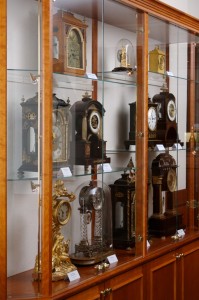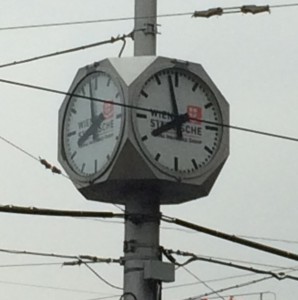Go with the Time(s)

The history of Viennese cubic clocks – part 1
For over 100 years, Vienna’s cityscape has been marked by cubic clocks, about 70 of which remain today. If you walk through the city with open eyes, you will surely discover them as well as many other public clocks that tell you the time. Although these days every single minute seems to matter, public clocks often go entirely unnoticed. This was not always the case:
Over the course of the 19th-century, it became more and more important to know the exact time due to industrialization, especially the advance in railroads. Timetables needed to be adhered to and people had to adjust to the prescribed rhythm. Clocks with second hands became indispensable, and pocket watches were very common and became status symbols. Tip: Take a look around the lobby and the restaurant of the Hotel Stefanie. Here you can see many elaborate old clocks on exhibit, which show how valuable time was to people already many years ago.
In the public space as well, the number of public clocks rose continuously. Many were located on church towers, such as St. Stephan’s Cathedral with its four different clocks, or on City Hall, which also has four clocks visible from various directions. So-called Ständeruhren (stand clocks), some of which were operated with air pressure, were mounted at heavily trafficked areas. The first of this type of clock was erected at the Naschmarkt in 1885.
Who turned the clock? The Viennese clock plight
All clocks had one thing in common: they had to be wound by hand, were therefore imprecise and for decades triggered discussions that entered the history books as the “Viennese clock plight,” since people set their private clocks according to the public clocks. It was possible for a single clock with multiple faces to show different times; differences of up to 10 minutes were not uncommon.
An achievement – the electric cubic clock
As an up-and-coming metropolis, this needed to be fixed. In the summer of 1907, the first electrically operated cubic clock went into operation at the intersection of Opernring and Kärntnerstrasse, mounted on a lamp post approximately seven meters tall. In place of the three-sided stand clocks, this new casing had four sides with round clock faces, without Roman numerals, but instead with points or dashes marking the minute, illuminated from the back and thereby easily legible to everyone during the day or at night. The chamfered edges offered better visibility, and together with a convex top, water could easily run off.
These clocks were driven by a “master clock” in the nearest advertising pillar, into which a power reserve was also built, which set the correct time after a power outage. The clocks only had to be re-adjusted only once or twice a year.
The populace received this innovation favorably, as it blended easily into the street picture and did not require a separate space.
How does the story continue? Find out here: part 2
http://www.wien.gv.at/kultur/archiv/geschichte/zeugnisse/wuerfeluhr.html
http://de.wikipedia.org/wiki/Wiener_W%C3%BCrfeluhr
Quelle: Peter Payer, Zeit-Zeugen, Zur Geschichte der Wiener-Würfeluhr, in: Normalzeit












